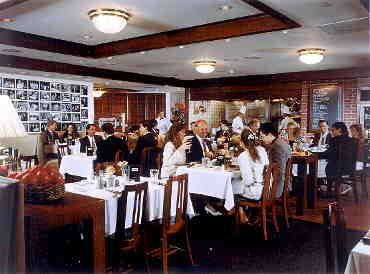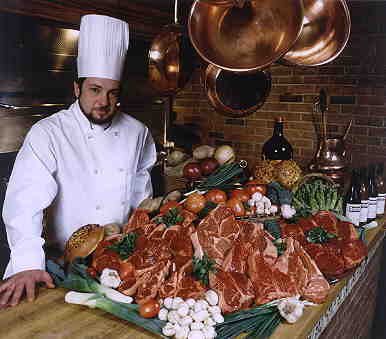
Morton's Steak House
How Does a GREAT STEAK Get That Way
by
Nick Anis

In spite of declining beef consumption in the US, the sales of Mortons of Chicago steak houses have risen dramatically. The reasons for this 30 restaurant strong chain's phenomenal success include their expansion into strategic locations in high growth economic areas, their impeccable service, and of course, their superb food. Complimenting the spectacular fare is an uptown ambiance with an open kitchen and an informative if not entertaining "multimedia" tableside presentation of the menu.
A stainless steel cart laden with uncooked shrink-wrapped cuts of prime beef, veal, chicken, swordfish, 3.5 pound live (but restrained) Maine lobster, giant 1 pound plus russet potatoes and beef steak tomatoes, and towering stalks of broccoli arrives - all so exceptional they put the best of cookbook photos to shame. Using these very eatable props your waiter describes the menu in delicious detail - without even breaking stride from occasional interruptions or questions. And what's more it's not just a spiel, each of the staff knows all about the food and how it's all prepared - and therein lies the tale.
How a great steak gets that way is no accident. Unfortunately, today's well breed genetically engineered cattle still don't offer any guarantee against inaccurately cooked or improperly prepared steaks that occasionally turn up at even some of the best steak houses. Mortons, however, does it right from the farm to your plate.
It all starts with the birth of a male calf (probably a cross bread of Hereford, Angus, and Charalais) on a cattle farm in the Spring weighing about 80 pounds. By mid September after nursing for about six months, reaching a weight of 350 to 650 pounds, and being weaned it is either sold as a feeder calf or sent on for grazing until the following spring. The feder calfs spends the next six months or so on a feeder lot eating lots of grain and corn and gaining an average of about 2.5 pounds a day.
In the late 1970's the USDA standards were somewhat adjusted for today's leaner cattle that has been genetically engineered over several generations and typically feed a diet of grain and corn. Lighter weight grass fed cattle, however, ends up being classified as "select" or "choice" and seldom qualifies for the USDA's highest beef rating, "prime" because it lacks the prescribed "moderately abundant" marbling of fat.
Even if beef gets the coveted USDA's prime rating it must also be accepted by Mortons' discriminating buyers in order to make it to your table. At this point cattle buyers employed by one of Mortons' 2 meat packers evaluate the 1000 to 1500 pound animals rated by the USDA as prime, and selects and negotiates the purchase of the amount of meat and cuts they are commissioned to buy.
Instead of buying all 800 pounds of dressed meat that is cut from a 1200 pound animal Mortons pays a bit more ($11 to $15 per pound) because their packers cut, trim, and age only the "cuts" they want in accordance with their demanding specifications.
Next, the meat is aged. Mortons does NOT dry age their beef. Although dry aging has nostalgic appeal, the process which involves hanging a slab of beef on a hook in a chilled meat locker and scraping any mold, is steadily being replaced with "wet" aging. According to company president, Thomas J. Walters "wet or Cryovac aging is used because it has less waste and produces tastier and more tender beef." Wet aging involves heat sealing various cuts of beef in polyethylene bags (with most of the air removed) and storing it at 34 degrees for up to 30 days. During this time Walters says "an enzyme created by the bacterial action in the meat naturally beaks down muscle which, in turn increases tenderness and flavor."
The finished steaks are vacuum packed and shipped by refrigerated trucks to each of Mortons' 30 restaurants, where they or one of their cousins will be paraded in front of you, selected, and cooked, and served within their brief 10-day shelf life.

So "here's the beef" ready for you to choose; incredibly tender 14-ounce filet, flavorful 24 or 48-ounce Porterhouse (my favorite), 20-ounce New York sirloin strip, or 16-ounce rib eye. The 3-inch steaks are slapped under a 1500 degree grill for searing on each side. To prevent over charring of the 48-ounce porterhouse after both sides are seared it's removed from the grill and finished in a 500 degree oven where it is carefully roasted to the correct internal temperature. The superthick filet can be butterfly cut before grilling to achieve higher internal temperatures without too much charring. There are no gimmicks such as sizzling platters, added fat, butter, or sauces - just tender, juicy, flavorful steak properly prepared, briefly set in its own juices, and then swiftly delivered to your table.
When your plate arrives with one of these masterpieces it takes only a single bite to reflect just how delicious a properly prepared steak can be. As you position your linen napkin on your lap, grasp your heavy duty rosewood handled serrated steak knife in one hand, and your fork in the other, your only regret will be the numerous portions of Mortons' scrumptious fresh out of the oven egg and onion bread you scarfed up along with appetizers such as shrimp cocktail, oysters, fresh lump crabmeat cocktail, saut‚ed mushrooms, home made soups, and chilled crisp salads. Entrees average $26, side dishes $5, and appetizers range from $8 to 10.
Mortons has an extensive wine list with bottles ranging from $25 to $150, including wines from California, France, Germany, and Italy. Reservations are strongly recommended. Mortons has five restaurants in California, near South Coast Plaza in Costa Mesa, (1661 Sunflower Avenue, South Coast Plaza Village, 714-444-4834), in Palm Desert at 74-880 Country Club Drive, in Beverly Hills at 435 South La Cienega, called "Arnie" Mortons of Chicago to avoid confusion with the Melrose Avenue restaurant "Morton," and in Sacramento, and San Francisco.
Nick Anis is a computer and technology writer and the author of 24 books who also writes about travel and leisure, and family vacationing. When not on the freeway, Nick can be reached on the superhighway at NickAnis@aol.com and TravelWatch@citivu.com, or at 909-860-6914 voice, 909-396-0014 fax.
(Nick Anis, Travel Watch, 909-860-6914)